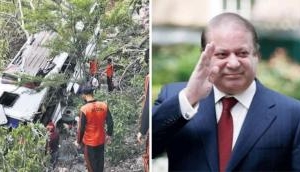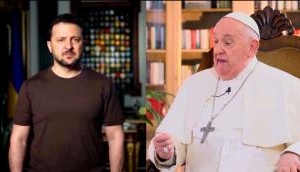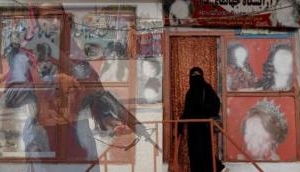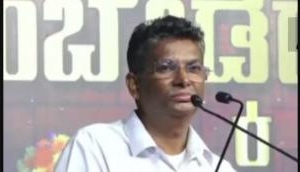_101484_730x419-m.jpg)
Ajj Aakhan Waris Shah Nuu,
Kiton Qabraan Wichon Bol,
Tey Ajj Kitaab-e-Ishq Daa,
Koi Agla Warka Phol
Ikk Royi Sii Dhi Punjab Di,
Tu Likh Likh Maarey Wain,
Ajj Lakhaan Dhiyan Rondiyan,
Tenu Waris Shah Nuu Kain
Uthh Dard-Mandaan Diya Dardiya,
Utth Tak Apna Punjab
Ajj Bailey Lashaan Bichiyaan
Tey Lahoo Di Bhari Chenab
[Today, I call Waris Shah,
Speak from inside your grave,
and of the book of love
turn the next affectionate page.
When one daughter of Punjab had cried,
You wrote a wailing saga,
Today a hundred thousand daughters,
cry to you Waris Shah.
Rise! O’ narrator of the grieving,
Rise! look at your Punjab
Today, fields are lined with corpses,
and blood fills the Chenab]
RD Kailey, a local singer, mesmerised the audience with this powerful Amrita Pritam poem at Punjab Arts Council's 'Bandanwar' programme Friday in Chandigarh. As Kailey went on, this reporter's mind wandered from Punjab to Gujarat. To 2002.
Pritam wrote to bring out the misery of the masses engulfed in post-partition riots. I could not help comparing and pondering how true those lines held hold for what Punjab and Bengal suffered in 1947; and what the victims of the 2002 Godhra incident and the following anti-Muslim pogrom went through.
Many thought what happened in Gujarat was a culmination of the processes of communal strife fostered by right-wing forces; the Hindutva groups that established their laboratory in the state. After all, they did experiment with the Christians in 1998 and 1999 what they managed to finally achieve on Muslims, their target to justify all the ills pervading the Indian polity and economy.
But they were wrong. It was not a culmination of the process of hate and violence that had been unleashed. Gujarat was just an important junction: yet another large-scale experiment to see what it could yield in terms of electoral victories; as a formula for expanding political ground in which communal polarisation would play a major role in demolishing political opposition by raising the bogey of fear and hate.
The Gujarat impact has certainly had a multiplier effect. Across India we see an amplification of the Gujarat model.
I am compelled to draw parallels between the Parsi couple Roopa and Dara Mody whose son had gone missing during the attack on the Gulbarg Society in 2002 and Fatima Nafees, mother of missing Jawahar Lal University (JNU) student Najeeb Ahmed.
They can well understand each ohter's plight. Their resilience can be equated with that of the aged Zakia Jafri, the widow of former Parliamentarian Ehsan Jafri who was hacked to death in the Gulbarg Society, who continues to fight for justice.
Similarly, the victims of successive riots that have been rocking towns and cities of the Hindi heartland in the last few years like Saharanpur, Muzaffarnagar and more recently Kasganj are no different from what had happened in Ahmedabad, Vadodara, Lunawada, Dahod, Sabarkantha, Mehsana and other places in Gujarat in 2002.
After all, religious and caste polarisation continues to pay political dividends.
In Gujarat while the Dalits had been used to attack Muslims in 2002, they were converted into into targets in the era of cow vigilantism as has been reflected in the episode of public flogging in Una. It is a different matter that a large number of cows continue to perish in Gujarat after consuming poisonous fodder and no Sangh Parivar outfit ever protests there.
In other parts of India what has been unleashed in the name of cow is nothing but terror as can be gauged from the lynchings of Mohammed Akhlaq, Pehlu Khan and more recently Junaid Khan.
The era of police encounters that had come to define the nationalism of the police officers in Gujarat in the post 2002 years is now being reflected in Uttar Pradesh as well.
The country has recently been stunned by the scam involving the Punjab National Bank as well as some other banks. Gujarat had experienced it way back in the form of the episode involving Madhavpura Mercantile Co-operative Bank.
Amid all these are the questions surrounding the murder of former Gujarat home minister Haren Pandya and more recently the death of Judge Brijgopal Harkishan Loya.
Coming back to Gujarat, there were reports through the day of the victims observing 16th anniversary of the pogrom. This time the focus of the social activists has been on the continuing plight of the people who had been displaced in 2002 and continue to live a life of misery.
According to reports there are still 3,380 families or around 17,000 'Internally Displaced Persons' living in 83 rehabilitation colonies. The maximum of 17 such colonies are in Anand district followed by 15 in Ahmedabad, 13 in Sabarkantha, 11 in Panchmahals, eight in Mehsana, six in Vadodara, five in Aravalli and four each in Bharuch and Kheda.
These colonies lack basic amenities and those residing there do not have any ownership rights. The issue of ownership rights is snowballing into a contentious one that has placed several relief organizations in the dock. There are many social activists who feel that it is high time the victims got the ownership rights because the money spent on building these structures came from donors and not from any individual's pocket.
In certain cases the owners of the land on which these colonies have come up are reportedly seeking their land back. For the residents getting loans and availing other facilities is a big challenge because they cannot furnish residence proofs.
“The fact is that the residents of these colonies are hounded by musclemen and the people are simply helpless,” an activist said. Reports say that while 62 of the 83 colonies are totally unregularised, the remaining are only partially regularised.
“One good thing that has happened over the years is that there is a move towards the Dalit Muslim unity and the Patidars too have realised how they were used by the ruling dispensation in 2002. But the time right now is ripe to develop a second rung of activists within the Muslim community that can take up their issues,” social activist Mukhtar Ahmed said. He points out how ownership rights were given to victim couples in Halol-Kalol area of Panchmahals and there has been no problem now.
The victims of the pogrom are yet to put their lives back on track and many more like them are landing in miseries across the country after falling prey to the forces working for polarisation on caste and communal lines to keep drawing electoral benefits and trying to wipe out the political opposition along with the opposition from the common man on the streets.
Will this ever end? I can once again find an answer from a Punjabi song played in a bus in which I was traveling this weekend. It once again referred to partition and the lyrics went “Sanu sauda nahin pugda, Ravi to Chenab puchda ki haal hai Satluj da...” (We do not accept this deal where river Chenab is compelled to ask Ravi how is Satluj).
People have started asking questions and this is the first step to salvage their pride in being a multi-cultural and multi-ethnic society, a secular India striving for inclusive development and equal opportunities.
Edited by Joyjeet Das








![BJP's Kapil Mishra recreates Shankar Mahadevan’s ‘Breathless’ song to highlight Delhi pollution [WATCH] BJP's Kapil Mishra recreates Shankar Mahadevan’s ‘Breathless’ song to highlight Delhi pollution [WATCH]](https://images.catchnews.com/upload/2022/11/03/kapil-mishra_240884_300x172.png)

![Anupam Kher shares pictures of his toned body on 67th birthday [MUST SEE] Anupam Kher shares pictures of his toned body on 67th birthday [MUST SEE]](https://images.catchnews.com/upload/2022/03/07/Anupam_kher_231145_300x172.jpg)






